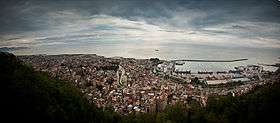Trabzon
| Trabzon | ||||||||
|---|---|---|---|---|---|---|---|---|
| Metropolitan Municipality | ||||||||
From top to bottom and left to right: Sumela Monastery viewed from across the Altındere valley; Atatürk's House; Lake Uzungöl; Hagia Sophia of Trabzon; Atatürk Square; a general view of the city centre from Boztepe. | ||||||||
| ||||||||
 Trabzon Location of Trabzon within Turkey. | ||||||||
| Coordinates: 41°00′N 39°44′E / 41.000°N 39.733°E | ||||||||
| Country |
| |||||||
| Province | Trabzon | |||||||
| Government | ||||||||
| • Governor | Yücel Yavuz | |||||||
| • Mayor | Orhan Fevzi Gümrükçüoğlu (AKP) | |||||||
| Area[1] | ||||||||
| • District | 188.85 km2 (72.92 sq mi) | |||||||
| Elevation | 0 m (0 ft) | |||||||
| Population (2012)[2] | ||||||||
| • Urban | 768.417 | |||||||
| • District | 312,060 | |||||||
| • District density | 1,700/km2 (4,300/sq mi) | |||||||
| Time zone | EET (UTC+2) | |||||||
| • Summer (DST) | EEST (UTC+3) | |||||||
| Postal code | 61xxx | |||||||
| Area code(s) | (+90) 462 | |||||||
| Licence plate | 61 | |||||||
| Climate | Cfa | |||||||
Trabzon (see other names, Turkish pronunciation: [ˈtrabzon]) is a city on the Black Sea coast of northeastern Turkey and the capital of Trabzon Province. Trabzon, located on the historical Silk Road, became a melting pot of religions, languages and culture for centuries and a trade gateway to Persia (Iran) in the southeast and the Caucasus to the northeast.[3] The Venetian and Genoese merchants paid visits to Trebizond during the medieval period and sold silk, linen and woolen fabric; the Republic of Genoa had an important merchant colony within the city called Leonkastron that played a role to Trebizond similar to the one Galata played to Constantinople (modern Istanbul).[4] Trabzon formed the basis of several states in its long history and was the capital city of the Empire of Trebizond between 1204 and 1461. During the early modern period, Trabzon, because of the importance of its port, became a focal point of trade to Iran and the Caucasus.
Name
The Turkish name of the city is Trabzon. It is historically known as Trebizond, Trapezund, Tribisonde and Trapezus. In Latin, Trabzon was called Trapezus, which is the latinization of the Ancient Greek Τραπεζοῦς (Trapezous), the first name of the city. (τράπεζα meant "table" in Ancient Greek; note the table on the coin in the figure.) Both in Pontic Greek and Modern Greek, it is called Τραπεζούντα (Trapezounda). In Ottoman Turkish and Persian, it is written as طربزون. During Ottoman times, Tara Bozan was also used.[5][6][7][8] Some western geographers used this name instead of the Latin Trebizond. In Laz it is known as ტამტრა (T'amt'ra) or T'rap'uzani,[9] in Georgian it is ტრაპიზონი (T'rap'izoni) and in Armenian it is Տրապիզոն Trapizon. The 19th-century Armenian travelling priest Byjiskian called the city by other, native names, including Hurşidabat and Ozinis.[10]
History
Iron Age and Classical Antiquity
The oldest area associated with the Kartvelians was northeastern Anatolia, including the Iron Age monarchy of the Diauehi (early-Georgians), later known as the culturally important region of T’ao-Klarjeti (part of Turkey since 1461), where they pre-dated the Hittites.[11][12][13]
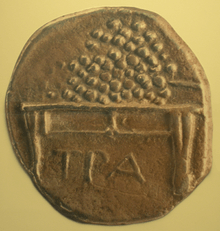
In classical antiquity the city was founded as Τραπεζοῦς (Trapezous) by Milesian traders (756 BC). It was one of a number (about ten) of Milesian emporia or trading colonies along the shores of the Black Sea. Others include Sinope, Abydos and Cyzicus (in the Dardanelles). Like most Greek colonies, the city was a small enclave of Greek life, and not an empire unto its own, in the later European sense of the word. Early banking (money-changing) activity is suggested occurring in the city according to a silver drachma coin from Trapezus in the British Museum, London.
Trebizond's trade partners included the Mossynoeci. When Xenophon and the Ten Thousand mercenaries were fighting their way out of Persia, the first Greek city they reached was Trebizond (Xenophon, Anabasis, 5.5.10). The city and the local Mossynoeci had become estranged from the Mossynoecian capital, to the point of civil war. Xenophon's force resolved this in the rebels' favor, and so in Trebizond's interest.
The city was added to the kingdom of Pontus by Mithridates VI Eupator and it became home port for the Pontic fleet.
When the kingdom was annexed to the Roman province of Galatia in 64–65, the fleet passed to new commanders, becoming the Classis Pontica. Trebizond gained importance under Roman rule in the 1st century for its access to roads leading over the Zigana Pass to the Armenian frontier or the upper Euphrates valley. New roads were constructed from Persia and Mesopotamia under the rule of Vespasian. In the next century, the emperor Hadrian commissioned improvements to give the city a more structured harbor.[14] A mithraeum now serves as a crypt for the church and monastery of Panagia Theoskepastos (Kızlar Manastırı) in nearby Kizlara, east of the citadel and south of the modern harbor.
Trebizond was greatly affected by two events over the following centuries: in the civil war between Septimius Severus and Pescennius Niger, the city suffered for its support of the latter, and in 258 the city was pillaged by the Goths, despite reportedly being defended by "10,000 above its usual garrison', and being defended by two bands of walls.[14]
Byzantine period and the Empire of Trebizond

Although Trebizond was rebuilt after being pillaged by the Goths in 258, the city did not soon recover. Only in the reign of Diocletian appears an inscription alluding to the restoration of the city; Ammianus Marcellinus could only write of Trebizond that it was "not an obscure town." Christianity had reached Trebizond by the third century, for during the reign of Diocletian occurred the martyrdom of Eugenius and his associates Candidius, Valerian, and Aquila.[15] By the time of Justinian, the city served as an important base in his Persian Wars, and Miller notes that a portrait of the general Belisarius "long adorned the church of St. Basil."[16] An inscription above the eastern gate of the city, commemorated the reconstruction of the civic walls following an earthquake at Justinian's expense.[16]
The city regained importance when it became the seat of the theme of Chaldia. Trebizond also benefited when the trade route regained importance in the 8th to 10th centuries; 10th-century Muslim authors note that Trebizond was frequented by Muslim merchants, as the main source transshipping Byzantine silks into eastern Muslim countries.[17] The Italian maritime republics such as the Republic of Venice and in particular the Republic of Genoa were active in the Black Sea trade for centuries, using Trabzon as an important seaport for trading goods between Europe and Asia.[4] Some of the Silk Road caravans carrying goods from Asia stopped at the port of Trebizond, where the European merchants purchased these goods and carried them to the port cities of Europe with ships. This trade provided a source of revenue to the state in the form of custom duties, or kommerkiaroi, levied on the goods sold in Trebizond.[18] The Greeks protected the coastal and inland trade routes with a vast network of garrison forts.[19]
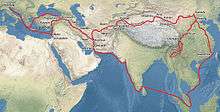
Following the Byzantine defeat at the Battle of Manzikert in 1071, Trebizond came under Seljuk rule. This rule proved transient when an expert soldier and local aristocrat, Theodore Gabras took control of the city from the Turkish invaders, and regarded Trebizond, in the words of Anna Comnena, "as a prize which had fallen to his own lot" and ruled it as his own kingdom.[20] Supporting Comnena's assertion, Simon Bendall has identified a group of rare coins he believes were minted by Gabras and his successors.[21] Although he was killed by the Turks in 1098, other members of his family continued his de facto independent rule into the next century.
The Fourth Crusade (1202–1204) and the Sack of Constantinople by the Latin Crusaders in April 1204 led to the dissolution of the Byzantine Empire. The Empire of Trebizond was formed in 1204 as one of the three Byzantine Greek successor states of the Byzantine Empire. Located at the far northeastern corner of Anatolia, it was the longest surviving of the Byzantine successor states, until its conquest by the Ottoman Turks in 1461. Geographically, the Empire of Trebizond consisted of little more than a narrow strip along the southern coast of the Black Sea, and not much further inland than the Pontic Mountains. Its demographic legacy endured for several centuries after the Ottoman conquest in 1461, as a substantial number of Greek Orthodox inhabitants, usually referred to as Pontic Greeks, continued to live in the area during Ottoman rule, up until 1923, when they were deported to Greece. A few thousand Greek Muslims still live in the area, mostly in the Çaykara-Of dialectical region to the southeast of Trabzon. Most are Sunni-Muslim, while there are some recent converts in the city and possibly a few Crypto-Christians in the Tonya/Gümüşhane area to the southwest of the city. Compared to most previously Greek cities in Turkey, a large amount of its Greek Byzantine architectural heritage survives as well.
On his return voyage from Asia in the late 13th century, Marco Polo ended his overland journey at the port of Trebizond, then the capital of the Empire of Trebizond, and sailed to his hometown Venice with a ship; passing by Constantinople (Istanbul) on the way, which was retaken by the Byzantines in 1261. A year earlier, in 1260, Niccolò and Maffeo Polo (the father and uncle of Marco Polo) were residing in Constantinople, then the capital of the Latin Empire. They foresaw a political change, liquidated their assets into jewels and moved away.[22] Their decision proved wise, as Constantinople was recaptured in 1261 by Michael VIII Palaiologos, the ruler of the Empire of Nicaea, who promptly burned the Venetian quarter in the city and reestablished the Byzantine Empire. Captured Venetian citizens in Constantinople were blinded,[23] while many of those who managed to escape perished aboard overloaded refugee ships fleeing to other Venetian colonies in the Aegean Sea. Constantinople remained the Byzantine capital until it was conquered by the Ottoman Sultan Mehmed II in 1453, who also conquered Trebizond eight years later, in 1461.
Ottoman era
.png)
The last Emperor of Trebizond, David, surrendered the city to Sultan Mehmed II of the Ottoman Empire in 1461.[24] Following this takeover, Mehmed II sent many Turkish settlers into the area, but the old ethnic Greek, Laz and Armenian communities remained. According to the Ottoman tax books (tahrir defterleri), the total population of adult males in the city was 1,473 in the year 1523.[25] Approximately 85% of them (1,252 adult males) were Christian, 13% of whom (197 adult males) were Armenian, and 15% of them (221 adult males) were Muslim.[25] However, a large portion of the local Christians were Islamized and Turkified by the end of the 17th century, according to a research by Prof. Halil İnalcık on the tax books (tahrir defterleri) of the Ottoman Empire. Trabzon was sanjak centre in Rum Eyalet (1461-1514) and (1520-1535), Erzincan-Bayburt eyalet (1514-1517), Anadolu Eyalet (1517-1520) and Erzurum Eyalet (1535-1598).[26]
Trabzon was the capital of the Ottoman Eyalet of Trebizond (1598–1867) and later of the Ottoman Vilayet of Trebizond (1867–1923) in the northeastern part of Anatolia. During the reign of Sultan Bayezid II, his son Prince Selim (later Sultan Selim I) was the sancakbeyi of Trabzon, and Selim I's son Suleiman the Magnificent was born in Trabzon on November 6, 1494. The Ottoman government often appointed local Chepni and Laz beys as the regional beylerbeyi. It is also recorded that some Bosniak beys were also appointed by the Sublime Porte as the regional beylerbeyi in Trabzon. The Beylerbeylik of Trabzon (Trabzon Beylerbeyliği) had always sent troops for the Ottoman campaigns in Europe during the 16th and 17th centuries.
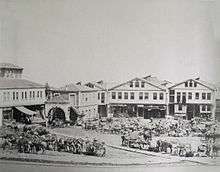
Trabzon had a wealthy merchant class during the late Ottoman period, and the local Christian minority had a substantial influence in terms of culture, economy and politics. A number of European consulates were opened in the city due to its importance in regional trade and commerce. In the first half of the 19th century Trabzon even became the main port for Persian exports. However, the opening of the Suez Canal greatly diminished the international trading position of the city. In the last decades of the 19th century the city saw some demographic changes. Many Christian from wider region started to migrate to the Crimea and southern Ukraine, in search for farmland or employment in one of the booming cities along the northern and eastern coasts of the Black Sea. At the same time, thousands of Muslim refugees from the Caucasus arrived in the city.

Next to Constantinople, Smyrna and Selanik, Trabzon was one of the cities where western cultural and technological innovations were first introduced to the Ottoman Empire. Hundreds of schools were constructed during the first half of the 19th century, giving the region one of the highest literacy rates of the empire. The city got a post office in 1845. New churches and mosques were built in the second half of the 19th century, as well as the first theater, public and private printing houses, multiple photo-studios and banks. The oldest known photographs of the city center date from the 1860s and depict one of the last camel trains from Persia.
Around a thousand Armenians are believed to have been killed in the Trebizond vilajet during the Hamidian massacres of 1895. While this number was low in comparison to other Ottoman provinces, its impact on the Armenian community in the city was large. Many prominent Armenian residents, among them scholars, musicians, photographers and painters, decided to migrate towards the Russian Empire or France. Due to the high number of Western-Europeans in the city, news from the region was being reported on in many European newspapers. These western newspapers were in turn also very popular among the residents of the city.
Modern era
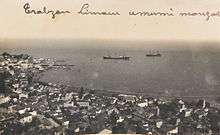
| Historical population | ||
|---|---|---|
| Year | Pop. | ±% |
| 1927 | 24,634 | — |
| 1950 | 33,990 | +38.0% |
| 1960 | 53,039 | +56.0% |
| 1965 | 65,516 | +23.5% |
| 1970 | 80,795 | +23.3% |
| 1975 | 97,210 | +20.3% |
| 1980 | 108,403 | +11.5% |
| 1985 | 155,960 | +43.9% |
| 1990 | 161,886 | +3.8% |
| 2000 | 214,949 | +32.8% |
| 2007 | 229,326 | +6.7% |
| 2009 | 230,027 | +0.3% |
In 1901 the harbour was equipped with cranes by Stothert and Pitt of Bath in England. The city was the site of one of the key battles between the Ottoman and Russian armies during the Caucasus Campaign of World War I which resulted in the capture of Trabzon by the Russian Caucasus Army under command of Grand Duke Nicholas and Nikolai Yudenich in April 1916. Russian general Shvartz's army caused a massive destruction in Trabzon.[27] Russians banned Muslim mosques, and forced Turks, who were the largest ethnic group living in the city, to leave Trabzon.[27] The Russian Army ultimately retreated from the city and the rest of eastern and northeastern Anatolia with the Russian Revolution of 1917.
Trabzon was a major Armenian extermination centre during the Armenian Genocide, as well as a location of subsequent trials (see Trabzon during the Armenian Genocide). Many of the victims were taken out to sea in boats that were then capsized.[28] The Trabzon trials reported Armenians having been drowned in the Black Sea.[29]
Following the Turkish War of Independence and the annulment of the Treaty of Sèvres (1920) which was replaced by the Treaty of Lausanne (1923), Trabzon again became a part of Turkey. During the war several Christian Pontic Greek communities in the Trebizond vilajet rebelled against the new army of Mustafa Kemal, but when nationalist Greeks came to Trabzon to proclaim revolution, they were not received with open arms by the local Pontic Greek population of the city. At the same time the Muslim population of the city protested the arrest of prominent Christians, and the government of Trabzon refused arms to Mustafa Kemal's henchman Topal Osman, who was responsible for mass murders in the western Pontus. Osman was forced out of the city by armed Turkish port-workers. Osman would eventually murder parliamentarian Ali Şükrü Bey from Trabzon for his criticism of the nationalist government of Mustafa Kemal.[30] Ali Şükrü Bey, who had studied in the United Kingdom and led the first Turkish opposition party, is seen as a hero by the people of Trabzon, while in neighboring Giresun there is a statue of his murderer Topal Osman. The efforts of the pro-Ottoman, anti-nationalist population of Trabzon only postponed the inevitable, because the national governments of Turkey and Greece in January 1923 agreed to a mutual forced population exchange. This exchange included well over one hundred thousand Greeks from Trabzon and the vicinity, to the relatively new Greek state, along with the Christian population of Ionia (over a million people).[31]
During World War II shipping activity was limited because the Black Sea had again become a war zone. Hence, the most important export products, tobacco and hazelnut, could not be sold and living standards degraded.
As a result of the general development of the country, Trabzon has developed its economic and commercial life. The coastal highway and a new harbour have increased commercial relations with central Anatolia, which has led to some growth. However, progress has been slow in comparison to the western and the southwestern parts of Turkey.
Trabzon is famous throughout Turkey for its anchovies called hamsi, which are the main meal in many restaurants in the city. Major exports from Trabzon include hazelnuts and tea.
The city still has a sizable community of Greek-speaking Muslims, most of whom are originally from the vicinities of Tonya and Of. However, the Pontic Greek language (known as Romeiaka or Ποντιακά, Pontiaka) is spoken mostly by the older generations.[32]
Population
| Population | 2007 | 2008 | 2009 | 2010 | 2011 | 2012 | 2013 | 2014 | 2015 |
|---|---|---|---|---|---|---|---|---|---|
| Total | 740,569 | 748,982 | 765,127 | 763,714 | 757,353 | 757,898 | 758,237 | 766,782 | 768,417 |
| Urban | 396,646 | 390,797 | 408,103 | 415,652 | 757,353 | 757,898 | 758,237 | 766,782 | 768,417 |
| Source: TurkStat (Turkish Statistical Institute)[33] | |||||||||
Geography and climate
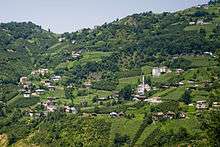
Trabzon Province has a total area of 4,685 square kilometres (1,809 sq mi) and is bordered by the provinces of Rize, Giresun and Gümüşhane. The total area is 22.4% plateau and 77.6% hills. The Pontic Mountains pass through the Trabzon Province.
Trabzon used to be an important reference point for navigators in the Black Sea during harsh weather conditions. The popular expression "perdere la Trebisonda" (losing Trebizond) is still commonly used in the Italian language to describe situations in which the sense of direction is lost.[4] The Italian maritime republics such as Venice and in particular Genoa were active in the Black Sea trade for centuries.[4]
Trabzon has four lakes, Uzungöl, Çakırgöl, Sera and Haldizen Lakes. There are several streams, but no rivers in Trabzon.
Climate
Trabzon has a climate typical of the Black Sea region with plentiful precipitation. Under the Köppen climate classification, it has a humid subtropical climate (Köppen: Cfa)[34] Summers are warm and humid, and the average maximum temperature is around 26.7 °C (80 °F) in August. Winters are cool and damp, and the lowest average minimum temperature is around 5 °C (41 °F) in January. Trabzon's summers are warmer than oceanic classifications, but the narrow fluctuations in temperature renders a significant influence from the sea. As with other major cities on the Black Sea coast of Turkey, Trabzon is situated right on the waterfront, thus allowing for the additional 1-2 degrees Celsius enough to surpass the threshold to be classified as subtropical. In comparison, only 1 or 2 percent of the province is classified as subtropical, the majority being oceanic (Köppen: Cfb) followed by humid continental climate (Köppen: Dfb), due to the immediate elevation increase starting from the coast, a typical characteristic of the Black Sea coast of Turkey. Trabzon's weather station also sees tendencies of a mediterranean climate (Köppen: Csa), but with only one month below 40 mm rainfall in summer it just fails to qualify.
Precipitation is heaviest in autumn and winter, with a marked reduction in the summer months, a microclimatic condition of the city center compared to the rest of the region. Snowfall is quite common between the months of December and March, snowing for a week or two, and it can be heavy once it snows.
The water temperature, like in the rest of the Black Sea coast of Turkey, is always cool and fluctuates between 8 °C (46 °F) and 20 °C (68 °F) throughout the year.
| Climate data for Trabzon | |||||||||||||
|---|---|---|---|---|---|---|---|---|---|---|---|---|---|
| Month | Jan | Feb | Mar | Apr | May | Jun | Jul | Aug | Sep | Oct | Nov | Dec | Year |
| Record high °C (°F) | 25.9 (78.6) |
28.2 (82.8) |
35.2 (95.4) |
37.6 (99.7) |
37.8 (100) |
35.9 (96.6) |
37.0 (98.6) |
34.8 (94.6) |
33.2 (91.8) |
33.8 (92.8) |
30.3 (86.5) |
26.4 (79.5) |
37.8 (100) |
| Average high °C (°F) | 10.9 (51.6) |
11.0 (51.8) |
12.2 (54) |
15.6 (60.1) |
19.2 (66.6) |
23.5 (74.3) |
26.2 (79.2) |
26.8 (80.2) |
24.0 (75.2) |
20.1 (68.2) |
16.5 (61.7) |
13.1 (55.6) |
18.26 (64.88) |
| Daily mean °C (°F) | 7.5 (45.5) |
7.4 (45.3) |
8.5 (47.3) |
11.9 (53.4) |
16.0 (60.8) |
20.4 (68.7) |
23.2 (73.8) |
23.5 (74.3) |
20.4 (68.7) |
16.5 (61.7) |
12.7 (54.9) |
9.6 (49.3) |
14.8 (58.6) |
| Average low °C (°F) | 4.7 (40.5) |
4.4 (39.9) |
5.6 (42.1) |
8.8 (47.8) |
13.0 (55.4) |
17.2 (63) |
20.1 (68.2) |
20.6 (69.1) |
17.5 (63.5) |
13.6 (56.5) |
9.8 (49.6) |
6.7 (44.1) |
11.83 (53.31) |
| Record low °C (°F) | −7.0 (19.4) |
−6.1 (21) |
−5.0 (23) |
−2.0 (28.4) |
5.2 (41.4) |
9.2 (48.6) |
13.5 (56.3) |
13.8 (56.8) |
8.5 (47.3) |
3.4 (38.1) |
−1.6 (29.1) |
−3.1 (26.4) |
−7 (19.4) |
| Average precipitation mm (inches) | 79.0 (3.11) |
61.0 (2.402) |
58.5 (2.303) |
57.2 (2.252) |
52.7 (2.075) |
50.7 (1.996) |
34.4 (1.354) |
45.5 (1.791) |
78.1 (3.075) |
116.4 (4.583) |
96.1 (3.783) |
80.6 (3.173) |
810.2 (31.897) |
| Average rainy days | 13.2 | 12.5 | 14.0 | 14.4 | 13.6 | 11.4 | 8.2 | 9.3 | 11.7 | 13.4 | 12.6 | 12.8 | 147.1 |
| Average relative humidity (%) | 69 | 69 | 73 | 75 | 77 | 75 | 73 | 73 | 74 | 73 | 70 | 68 | 72.4 |
| Mean monthly sunshine hours | 83.7 | 89.6 | 105.4 | 129.0 | 176.7 | 210.0 | 179.8 | 167.4 | 150.0 | 133.3 | 108.0 | 80.6 | 1,613.5 |
| Mean daily sunshine hours | 2.8 | 3.3 | 3.5 | 4.3 | 5.7 | 7.1 | 6.1 | 5.7 | 5.0 | 4.6 | 3.7 | 2.8 | 4.55 |
| Source #1: Turkish State Meteorological Service [35] | |||||||||||||
| Source #2: Weatherbase[36] | |||||||||||||
Economy
As of 1920, the port at Trabzon, was considered "the most important of the Turkish Black Sea ports", by the British. It traded as far as Tabriz and Mosul. As of 1911, Central Bank of the Republic of Turkey signed an agreement to develop a harbor at the port. When the Russians occupied Trabzon, a mole was built.[37] They built a breakwater and were responsible for creating an extended pier, making loading and unloading easier. In 1920, Trabzon produced linen cloth, silver filagree, tanning and small amounts of cotton, silk and wool. Tobacco and hazelnuts were exported.[38] The tobacco produced in Trabzon was called Trebizond-Platana. It was described as having "large leaves and a bright colour."[39] Trabzon was known for producing poor quality cereals, most which were grown for local use.[40]
Trabzon produced a white green bean, which was sold in Europe. It was, as of 1920, the only vegetable exported out of the province.[39] Poultry farming was also popular in Trabzon. Sericulture was seen in the area before 1914.[41] The area produced copper, silver, zinc, iron and manganese. Copper was kept for local use by coppersmiths. During the Balkan Wars production ceased due to poor exportation and fuel supplies.[42]
People


The current ethnic background of the people of Trabzon is mostly Turkish.[43][44] There are also descendants of Circassian muhajiris[45] in the city, as well as smaller number of Laz people, Muslim Greeks (Romeyka-speakers) and Armenians (Hemshin).[43][46] Local Turks are mostly of Chepni Turkmen origin.[47] The main language of these ethnic groups is Turkish.[48] Modern migration since the dissolution of the Soviet Union has brought a significant number of Russians, Ukrainians and people from the Caucasus (mostly Georgia) into the city. Russian language shops and facilities can be found in the town.
Pontic Greek has been spoken in the region since early antiquity. The local dialect developed along its own lines and is today partly intelligible to speakers of Standard Greek. It was spoken mainly by a Greek Orthodox multi-ethnic population up to the population exchange; nearly all speakers of this local variant of Pontic Greek are now Muslims. A very similar dialect is spoken by a community of about 400 speakers, descendants of Christians from the Of valley now living in Greece in the village of Nea Trapezounta (New Trebizond), today part of Katerini, Central Macedonia.[49]
Laz people, who are aboriginal to this area, also live in Trabzon. Numerous villages inside and out of Trabzon of the Laz date back as early as the period of Queen Tamar's rule (Georgian: თამარი, also transliterated as T'amar or Thamar; c. 1160 – 18 January 1213) in the newly unified Kingdom of Georgia. During the Queen's rule, sizeable groups of immigrating Georgians moved to Trabzon where they continue to preserve their native tongue. There was an Armenian community in Trebizond as early as the 7th century.[50]
During the 13th and 14th centuries, numerous Armenian families migrated here from Ani.[50] Robert W. Edwards published part of an early 15th-century diary from the Castilian ambassador who visited Trabzon and compared the churches of the Greek and Armenian communities.[51] It was stated by the ambassador that the Armenians, who were not well like by the Greeks, had a population large enough to support a resident bishop. According to Ronald C. Jennings, in the early 16th century, Armenians made up approximately 13 percent[52] of the city's population.[53] At present, Trabzon does not have an Armenian-speaking community.
The Chepni people, a tribe of Oghuz Turks who played an important role in the history of the eastern Black Sea area in the 13th and 14th centuries, live in the Şalpazarı (Ağasar valley) region of the Trabzon Province.[54] Very little has been written on the Turkification of the area. There are no historical records of any considerable Turkish-speaking groups in the Trabzon area until the late 15th century, with the exception of the Chepnis. The original Greek (and in some regions Armenian) speakers imposed features from their mother language into the Turkish spoken in the region. Heath W. Lowry's[55] work with Halil İnalcık on Ottoman tax books (Tahrir Defteri)[56] provides detailed demographic statistics for the city of Trabzon and its surrounding areas during the Ottoman period.
It is possible that the majority of the population of Trabzon and Rize (and other ancient Greek colonies in the Pontus region) — except up to the time of the Chepni Turk immigration waves — consisted of indigenous Caucasian tribes (the Colchians and the Laz) who had been partly Hellenized religiously and linguistically.[57] Michael Meeker stresses the cultural resemblances (e.g. in village structure, house types, and pastoral techniques) between the Eastern Black Sea coast and the areas in the Caucasus proper.[58]
Main sights
Trabzon has a number of tourist attractions, some of them dating back to the times of the ancient empires that once existed in the region. In the city itself, one can find a hub of shops, stalls and restaurants surrounding the Meydan, a square in the center of the city, which includes a tea garden.
- The Hagia Sophia (Turkish: Ayasofya Müzesi), a stunning Byzantine church, is probably the town's most important tourist attraction.
- Trabzon Castle ruins are visible in the town but cannot be visited as they fall in a military zone. The outside wall of the castle now serves as the back wall of a military building.
- The "Atatürk Köşkü" is a villa built in 1890 by a local Greek merchant. In 1924 Mustafa Kemal Atatürk stayed in the villa during his visit to Trabzon. He stayed there again in 1937. It houses period rooms and serves as a monument to the memory of the founder and first President of the Republic of Turkey.
- Boztepe Park is a small park and tea garden on the hills above Trabzon that has a panoramic view of nearly the entire city. The terrain in Trabzon is ascending in such a way that although the view is far above that of the buildings below, it is still close enough to be able to observe the flow of traffic and the people moving about in the city.
- Uzun Sokak is one of the most crowded streets of Trabzon.
- Trabzon Museum is located in the town centre and offers interesting exhibits on the history of the region, including an impressive collection of Byzantine artifacts.
- Trabzon's Bazaar District offers interesting shopping opportunities on ancient narrow streets, continuing from Kunduracılar Street from the Meydan (town square).
- Kostaki Mansion is located to the north of Zeytinlik near Uzun Sokak.
Other sites of the city include: Fatih Mosque (originally the Panagia Khrysokephalos Church), Yeni Cuma Mosque (originally the Agios Eugenios Church), Nakip Mosque (originally the Agios Andreas Church), Hüsnü Köktuğ Mosque (originally the Agios Elevtherios Church), İskender Pasha Mosque, Semerciler Mosque, Çarşı Mosque, Gülbahar Hatun Mosque and Türbe (commissioned by Sultan Selim I), Kalepark (originally Leonkastron).
Within Trabzon Province, the main attractions are the Sümela Monastery (i. e. the Monastery of the Panagia Soumelá) and the Uzungöl lake. The monastery is built on the side of a very steep mountain overlooking the green forests below and is about 50 kilometres (31 miles) south of the city. Uzungöl is famous for the natural beauty of the area and the amazing scenery. Other important sites of interest in the broader region include:
- Kaymaklı Monastery, a formerly Armenian Monastery of the All-Saviour (arm. Ամենափրկիչ Վանք, Amenaprgič Vank),
- Kızlar Monastery of Panagia Theoskepastos (the God-veiled Virgin),
- Kuştul Monastery of Gregorios Peristereotas (gr. Ιερά Μονή του Αγίου Γεωργίου Περιστερεώτα, Ierá Moní tou Agíou Georgíou Peristereóta),
- Vazelon Monastery of Agios Savvas (Maşatlık),
- Cave churches of Agia Anna (Little Ayvasıl), Sotha (St. John), Agios Theodoros, Agios Konstantinos, Agios Christophoros, Agia Kyriakí, Agios Michail and Panagia Tzita churches.[59]
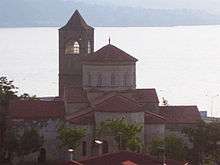
 Atatürk Köşkü
Atatürk Köşkü Atatürk Square
Atatürk Square
 Livera village
Livera village

Culture

Folk dancing is still very much in evidence in the Black Sea region. The "Horon" is a famous dance which is indigenous to the city and its surrounding area. It is performed by men, women, the young and elderly alike; in festivities, local weddings and harvest times.[60] While similar to Russian Cossack dances in terms of vividness, the Trabzon folk dance is probably indigenous to the eastern Black Sea region, which has an impressive variety of folk music .
The people of Trabzon have a reputation for being religiously conservative and nationalist. Many Trabzonites generally show a strong sense of loyalty to their family, friends, religion and country. Atatürk selected his presidential guards from Trabzon and the neighbouring city of Giresun because of their fierce fighting ability and their loyalty.
Outside of the relatively urban space of Trabzon proper, and within parts of it as well, rural traditions from the Black Sea village life are still thriving. These include traditional gender roles, social conservatism, hospitality and a willingness to help strangers; and all aspects, both positive and negative, of an agrarian lifestyle, such as hard work, poverty, strong family ties, and a closeness to nature.
The people of the eastern Black Sea region are also known for their wit and sense of humour; in fact many jokes in Turkey are told about the natives of the Black Sea region Karadeniz fıkraları (Black Sea jokes). The character Temel, a universal buffon figure found in many cultures, forms an important part of the Turkish oral tradition.
The city's profile was raised somewhat in the English-speaking world by Dame Rose Macaulay's last novel, The Towers of Trebizond (1956), which is still in print.[61]
Education

Black Sea Technical University in Trabzon hosts students from all over Turkey, especially from the Black Sea and East Anatolian regions, as well as students from the Turkic states in Central Asia.
Historically the city was a center of Greek culture and education and from 1683 to 1921, a teachers' college operated known as Phrontisterion of Trapezous, which provided a major impetus for the rapid expansion of Greek education throughout the region.[62] The building of this institution (built in 1902) still remains the most impressive Pontic Greek monument in the city and today hosts the Turkish school Anadolu Lisesi.[63]
Cuisine
Trabzon's regional cuisine is traditionally reliant on fish, especially hamsi (fresh European Anchovy similar to the British Sprat or American Smelt). Trabzon meets 20% of the total fish production in Turkey. Regional dishes include the Akçaabat köfte (spicy lamb meatball from the Akçaabat district), Karadeniz pidesi (canoe shaped pita bread, often filled with ground beef, cheese and eggs), kuymak (a Turkish fondue made with cornmeal, fresh butter and cheese), Vakfıkebir ekmeği (large country-style bread), Tonya tereyağı (Tonya butter), tava mısır ekmeği (deep-dish corn bread) and kara lahana çorbası (bean and cabbage soup). Taflan kavurması is a cherry laurel dish served with onions and olive oil. Trabzon is also famous for its hazelnuts. The Black Sea region of Turkey is the world's largest producer of cherry and hazelnut; and a large production area of tea; all of which play an important role in the local cuisine.
Sports
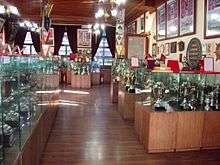
Football is the most popular sport in Trabzon. The city's top sports club, Trabzonspor, was until 2010 the only Turkish football club in Anatolia to win the Süper Lig (six times), which was previously (until Trabzonspor's first championship title in the 1975–76 season) won only by the "Big Three" clubs of Istanbul, namely Galatasaray, Fenerbahçe and Beşiktaş. Due to Trabzonspor's success, the decades-old term "Big Three" which defined the most successful football clubs in Turkey had to be modified into the "Big Four".
Trabzonspor is also one of the most successful Turkish clubs in the European Cups, managing to beat numerous prominent teams such as Barcelona, Inter, Liverpool, Aston Villa and Olympique Lyonnais. Renowned former players of Trabzonspor include Şenol Güneş, Lars Olsen and Shota Arveladze.
Trabzon hosted the First Edition of the Black Sea Games in July 2007 and the 2011 European Youth Summer Olympic Festival.
Notable residents
- Sunay Akın, Turkish poet and writer
- Engin Ardıç, Turkish writer and TV commentator
- Athanasius the Athonite, Greek Orthodox saint
- Adem Ayral, Turkish actor
- Cemal Azmi, Turkish governor
- Basilios Bessarion, Greek bishop, scholar and writer
- Gregory Choniades, Greek astronomer
- Ertem Eğilmez, Turkish film director
- Eugenius of Trebizond, Greek saint and martyr
- Bedri Rahmi Eyüboğlu, Turkish painter and poet
- Mualla Eyüboğlu Anhegger, Turkish architect[64]
- George of Trebizond, Greek philosopher, scholar and writer
- Erol Günaydın, Turkish actor
- Şenol Güneş, Turkish football player and manager
- Hayati Hamzaoğlu, Turkish actor
- Periklis Hristoforidis, Greek actor
- John VIII, Greek Orthodox Patriarch
- Adnan Kahveci, Turkish politician
- Tugay Kerimoğlu, Turkish football player
- Volkan Konak, Turkish musician
- Vartan Mahokian, Armenian painter
- Hami Mandıralı, Turkish football player
- Nuray Mert, Turkish journalist
- Altan Öymen, Turkish journalist, writer and politician
- Faruk Nafız Özak, Turkish politician and football player
- Michael Panaretos, Greek historian and statesman
- Ioannis Passalidis, Greek politician
- Dimitris Psathas, Greek playwright
- Fuat Saka, Turkish multi-instrumentalist
- Hasan Saka, Turkish prime minister
- Andrea Santoro, Italian Roman Catholic priest
- Osman Şirin, Turkish judge
- Suleiman the Magnificent, Turkish sultan
- Cevdet Sunay, Turkish president
- Leon Zaven Surmelian, Armenian-American writer
- Fatih Tekke, Turkish football player
- Koksal Baba, Turkish entertainer and disability rights activist
- Bahriye Üçok, Turkish theologist, politician, writer, columnist and women's rights activist
International relations
Twin towns—Sister cities
Trabzon is twinned with:
See also
- Empire of Trebizond
- World Trade Center Trabzon
- Trebizond Eyalet
- Trebizond Vilayet
- Trabzon Province
- Phrontisterion of Trapezous
- Trabzonspor
- The Towers of Trebizond
- Sümela Monastery
- Lake Uzungöl
- Black Sea Technical University (KTU)
- Black Sea
- Black Sea Region
- Kemençe of the Black Sea
- Horon
- Kolbastı
- Amasya (ancient Amaseia, capital of the Pontic Greeks during classical antiquity)
- Pontic Greeks
- Colchis
- Laz people
- Chepni people
- Anatolian Tigers
Notes and references
- ↑ "Area of regions (including lakes), km²". Regional Statistics Database. Turkish Statistical Institute. 2002. Retrieved 2013-03-05.
- ↑ "Population of province/district centers and towns/villages by districts - 2012". Address Based Population Registration System (ABPRS) Database. Turkish Statistical Institute. Retrieved 2013-02-27.
- ↑ Trabzon (tr)
- 1 2 3 4 William Miller (2009). The Latin Orient. Bibliobazaar LLC. pp. 51–54. ISBN 1-110-86390-X.
- ↑ Campbell, Lawrence Dundas, The Asiatic annual register, or, A View of the history of Hindustan, and of the Politics, Commerce, Literature of Asia, London 1802 Page:3 Google books link :
- ↑ Malte-Brun, Conrad, Universal geography: or a description of all parts of the world ..., Volume 2 Google Books link:
- ↑ The modern traveller, a popular description geographical, historical, and ... - Google Books
- ↑ Die Erdkunde im Verhältniss zur Natur und zur Geschichte des Menschen: oder ... - Carl Ritter - Google Books
- ↑ Türkçe Lazca sözlük / Çeviri / Online Çeviri / Lazuri.com
- ↑ Özhan Öztürk claims that Ozinis means "flat place" in Laz language and Hurşidabat means "City of the Sun" in Persian/Ottoman language. Pontus: Antik Çağ’dan Günümüze Karadeniz’in Etnik ve Siyasi Tarihi Genesis Yayınları. Ankara, 2011. pp.547-549 ISBN 978-605-54-1017-9
- ↑ Phoenix: The Peoples of the Hills: Ancient Ararat and Caucasus by Charles Burney, David Marshall Lang, Phoenix Press; New Ed edition (December 31, 2001)
- ↑ Ronald Grigor Suny, The Making of the Georgian Nation: 2nd edition (December 1994), Indiana University Press, ISBN 0-253-20915-3, page 45
- ↑ A Star in the East: July 2012
- 1 2 William Miller, Trebizond: The Last Greek Empire, 1926, (Chicago: Argonaut Publishers, 1968), p. 9
- ↑ Miller, Trebizond, p. 10
- 1 2 Miller, Trebizond, p. 11
- ↑ R.B. Serjeant, Islamic Textiles: material for a history up to the Mongol conquest, 1972, pp 63, 213, noted by David Jacoby, "Silk Economics and Cross-Cultural Artistic Interaction: Byzantium, the Muslim World, and the Christian West", Dumbarton Oaks Papers 58 (2004:197-240) p. 219 note 112.
- ↑ Speros Vryonis, The Decline of Medieval Hellenism in Asia Minor and the Process of Islamization from the Eleventh through the Fifteenth Century (Berkeley: University of California, 1971), p. 16
- ↑ Robert W. Edwards, “The Garrison Forts of the Pontos: A Case for the Diffusion of the Armenian Paradigm,” Revue des Études Arméniennes 19, 1985, pp.181-284.
- ↑ Miller, Trebizond, p. 12
- ↑ Bendall, . "The Mint of Trebizond under Alexius I and the Gabrades", Numismatic Chronicle, Seventh Series, 17 (1977), pp. 126-136
- ↑ Britannica 2002, p. 571
- ↑ Zorzi, Alvise, Vita di Marco Polo veneziano, Rusconi Editore, 1982
- ↑ Prothero, G.W. (1920). Anatolia. London: H.M. Stationery Office.
- 1 2 The Armenian People from Ancient to Modern Times, Richard G. Hovannisian, page 27/28, 2004
- ↑ http://www.ofhayrat.com/news_print.php?id=4895
- 1 2 Grand Larousse encyclopedia Turkish edition, 22, page: 11669, Librairie Larousse
- ↑ Toronto Globe, August 26, 1915.
- ↑ Takvimi Vekdyi, No. 3616, August 6, 1919, p. 2.
- ↑ Twice a Stranger: The Mass Expulsions that Forged Modern Greece and Turkey, p.112-116 Bruce Clark, 2006, Harvard University Press.
- ↑ Baum, Wilhelm (2006). The Christian minorities in Turkey. Kitab. p. 162. ISBN 978-3-902005-62-5. "On October 11, 1922, Turkey concluded an armistice with the allied forces, but not with the Greeks. The Greeks in the other settlement areas of Asia Minor were also expelled at that time, like e.g. the Kappadocian Greeks in the Goreme area and the other Greeks in Pontus, in the Trabzon area and on the west coast."
- ↑ Özhan Öztürk: Pontus: Antik Çağ’dan Günümüze Karadeniz’in Etnik ve Siyasi Tarihi, Genesis Yayınları, Ankara, 2011, pp. 417-421, ISBN 978-605-54-1017-9; Peter Mackridge: Greek-Speaking Muslims of North-East Turkey: Prolegomena to a study of the Ophitic sub-dialect of Pontic, Byzantine and Modern Greek Studies, Oxford University Press, 1987, pp. 115- 137; Ömer Asan: Pontus Kültürü, Belge Yayınları, Istanbul, 1996.
- ↑ TurkStat (Turkish Statistical Institute)
- ↑ Peel, M. C.; Finlayson, B. L.; McMahon, T. A. (2007). "Updated world map of the Köppen-Geiger climate classification" (PDF). Hydrology and Earth System Sciences. 4 (2): 439–473. doi:10.5194/hessd-4-439-2007. Retrieved 2011-02-27.
- ↑ "Trabzon". Turkish State Meteorological Service. Retrieved 1 September 2016.
- ↑ Trabzon, Turkey Travel Weather Averages (Weatherbase)
- ↑ Prothero, W.G. (1920). Armenia and Kurdistan. London: H.M. Stationery Office. p. 51.
- ↑ Prothero, W.G. (1920). Armenia and Kurdistan. London: H.M. Stationery Office. p. 52.
- 1 2 Prothero, W.G. (1920). Armenia and Kurdistan. London: H.M. Stationery Office. p. 61.
- ↑ Prothero, W.G. (1920). Armenia and Kurdistan. London: H.M. Stationery Office. p. 60.
- ↑ Prothero, W.G. (1920). Armenia and Kurdistan. London: H.M. Stationery Office. p. 64.
- ↑ Prothero, W.G. (1920). Armenia and Kurdistan. London: H.M. Stationery Office. p. 73.
- 1 2 Türkiye Cumhuriyeti Anayasası (1982)
- ↑ Türkiye Cumhuriyeti Anayasası, Madde 66
- ↑ IMMIGRANTS OF THE OTTOMAN EMPIRE - In 1868, 11 thousand from the Caucasus has settled in Adyghe
- ↑ Türkiye Cumhuriyeti Anayasası, Madde 66
- ↑ Sümer, Faruk, Çepniler
- ↑ Çelik, Ali, Doç.Dr., Çepnilerin Anadolu'nun Türkleştirilmesindeki Yeri Ve Önemi
- ↑ "www.latsis-foundation.org" (PDF). Retrieved 2011-10-29.
- 1 2 Victor Amazaspovich Ambartsumian; Abel Poghosi Simonyan; Makich Vahani Arzumanyan (1986). Haykakan sovetakan hanragitaran ("Soviet Armenian Encyclopedia") (in Armenian). 12. Yerevan. p. 87. OCLC 10431241.
- ↑ Robert W. Edwards, “Armenian and Byzantine Religious Practices in Early Fifteenth-Century Trabzon: A Spanish Viewpoint,” Revue des Études Arméniennes 23, 1992, pp.81-90.
- ↑ 15.5% of 85%
- ↑ Jennings, Ronald C. (Jan. 1976) Urban Population in Anatolia in the 16th Century: International Journal of MiddleEast Studies, Vol. 7, No. 1 pp. 21-57.
- ↑ Bernt Brendemoen, The Turkish dialects of Trabzon, University of Oslo, 2002 p18
- ↑ Professor. Department of Near Eastern Studies. Princeton University
- ↑ Trabzon Şehrinin İslamlaşması ve Türkleşmesi 1461–1583 ISBN 975-518-116-4
- ↑ Michael Meeker, "The Black Sea Turks: some aspects of their ethnic and cultural background", International Journal of Middle Eastern Studies (1971) 2:318–345
- ↑ Meeker, 1971: p. 326 "As the mentioned, the villages along the Black Sea coast from Ordu to Artvin are composed of many hamlets, each dominating a hilltop or mountain side on which its own crops are separately planted. This type of settlement pattern is in sharp contrast with the typical nucleated Anatolian village, but its characteristic of many rural settlements of the Western Caucasus notably those of Abkhaz, Circassians, Georgians, Mingrelians and Ossetes..."
For similar ideas See: Karl Koch, Reise duch Russland nach dem Kaukasis chen Istmus in den Jahren, 1836. vol1. p. 378; W.E.D. Allen, A History of the Georgian People, London 1932. pp. 54–5; Özhan Öztürk, Karadeniz. 2005. p. 35, 757–68. For linguistic influence see: Bernt Brendomoen, Laz influence on the Black Sea Turkish Dialects, 1990 (Proceedings from 32nd meeting of the Permanent International Altaistic Conference) - ↑ Karalahana.com
- ↑ People and culture of Trabzon and Black sea region
- ↑ Macaulay, Rose: The Towers of Trebizond (Collins, London, 1956)
- ↑ Özdalga, Elisabeth (2005). Late Ottoman society: the intellectual legacy. Routledge. p. 261. ISBN 978-0-415-34164-6.
- ↑ Bryer, Anthony; Winfield, David (2006). The post-Byzantine monuments of Pontos. Ashgate. p. xxxiii. ISBN 978-0-86078-864-5.
- ↑ Eğrikavuk, Işıl (2009-08-21). "Portrait of A Lady as a non-conformist". Hürriyet Daily News and Economic Review. Retrieved 2009-09-01.
- ↑ "Batumi - Twin Towns & Sister Cities". Batumi City Hall. Archived from the original on 2012-05-04. Retrieved 2013-08-10.
- Princeton Encyclopedia of Classical Sites eds. Richard Stillwell, William L. MacDonald, Marian Holland McAllister: "Trapezus"
- Özhan Öztürk (2005). Karadeniz (Black Sea): Ansiklopedik Sözlük. 2 Cilt. Heyamola Yayıncılık. Istanbul. ISBN 975-6121-00-9
- Bryer, Anthony; David Winfield (March 1985). Byzantine Monuments and Topography of the Pontos (Dumbarton Oaks Studies,20) Two Volume Set. Dumbarton Oaks Pub Service. ISBN 0-88402-122-X.
- CSMonitor.com
- New York Times
External links
| Wikimedia Commons has media related to Trabzon. |
| Wikivoyage has a travel guide for Trabzon. |
- Governorship of Trabzon
- Bus Ticket for Trabzon
- Uzungöl in Trabzon
- Trabzon Weather Forecast Information
- Historical postcards of Trabzon
- Photos of Trabzon city
- History of Trabzon in Karalahana.com
 |
Black Sea |  | ||
| Giresun | |
Rize | ||
| ||||
| | ||||
| Gümüşhane and Bayburt |
Coordinates: 41°00′N 39°44′E / 41.000°N 39.733°E


